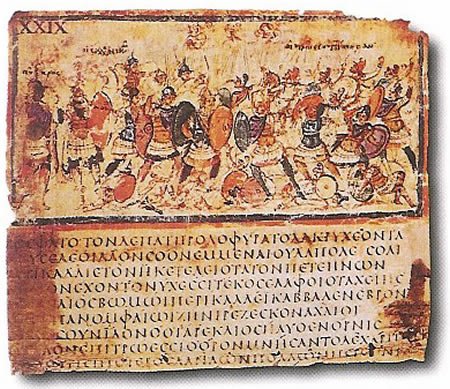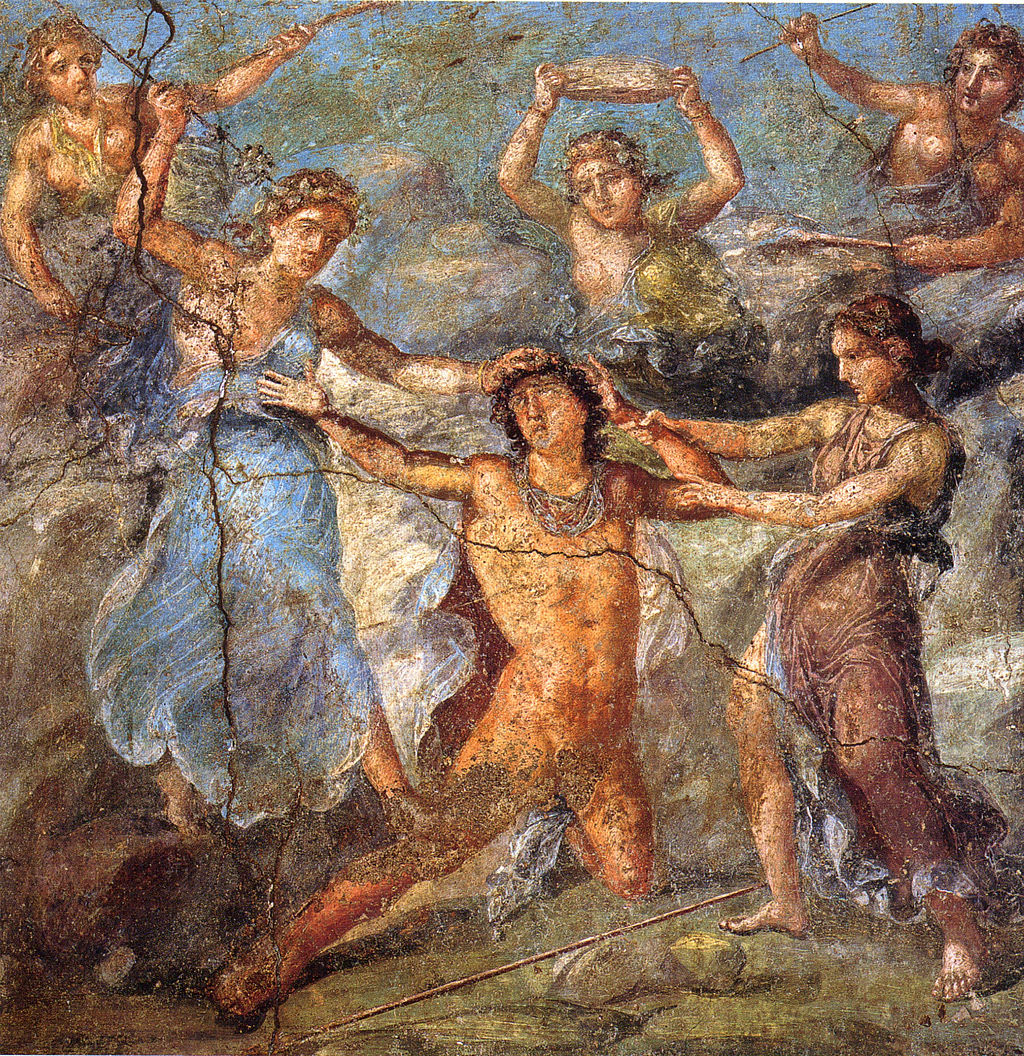In the swirling mists of early 6th century BCE Greek history, few figures shine brightly and fall as dramatically as Polycrates of Samos. His life reads like a tragic play, a meteoric rise to power, an era of unprecedented maritime dominance, cultural patronage that rivalled Athens, and ultimately, betrayal and death. Charismatic and cunning, ruthless yet visionary, Polycrates embodied the paradoxes of tyranny in ancient Greece. His story not only reveals the ambitions and anxieties of a Hellenic tyrant but also the fragile balance between power and hubris in the ancient world.
Terry Bailey explains.
Polycrates' Crucifixion by Salvator Rosa, circa 1664.
The Maritime Tyrant
Born around 538 BCE into the ruling elite of Samos, an island in the eastern Aegean Sea, Polycrates seized power during a time of political unrest. By 538 BCE, he had taken control of the island alongside his two brothers, Pantagnotus and Syloson, however, Polycrates was never one to share. Within a few years, he had orchestrated the exile and death of his siblings and became the sole ruler, a classic tyrant in the mold of his contemporaries, but more daring than most.
What set Polycrates apart was his bold vision of turning Samos from a minor island power into a dominant naval and commercial force in the Aegean. In a world where most tyrannies were land-based, Polycrates built his power upon the sea.
Naval Supremacy
Polycrates is best known for assembling one of the most powerful navies in the Greek world. According to Herodotus, he commanded 100 pentekonters (50-oared ships), a formidable force that allowed him to dominate the eastern Mediterranean. His fleet brought Samos wealth through trade and piracy, extending his influence beyond the island's shores.
This wealth allowed Polycrates to pour resources into cultural and architectural projects. The most famous is the Heraion, a grand sanctuary dedicated to the goddess Hera. The temple, with its massive columns and intricate sculptures, was considered a marvel of the ancient Greek world. It symbolized not only devotion to the gods but the reach and sophistication of Samian society under his reign.
Additionally, it was one most important ancient sanctuaries dedicated to the goddess Hera, the queen of the Olympian gods in Greek mythology. It was located near the ancient mouth of the Imbrasos River, where legend claimed Hera was born under a lygos tree. The sanctuary became a major center of worship from the early Iron Age, growing in prestige and architectural grandeur throughout the Archaic and Classical periods.
The centerpiece of the sanctuary was the great Temple of Hera, an ambitious structure that went through multiple phases of construction. The most famous version, built around 570 BCE by the architects Rhoikos and Theodoros was among the first of the colossal Ionic temples in the Greek world. This temple featured 155 columns, some of which stood over 20 meters tall, making it one of the earliest and largest dipteral temples, (with two rows of columns surrounding the cella). Although it was destroyed by an earthquake and fire before completion, its scale and technical innovation demonstrated the wealth and ambition of Samos at the time.
Excavations at the Heraion have revealed rich offerings made to the goddess, including jeweler, statues, weapons, and even imported artefacts from Egypt and the Near East. These finds reflect not only religious devotion but also Samos's status as a significant player in Aegean and Eastern Mediterranean trade networks. The sanctuary's importance continued through the Classical and Hellenistic periods, although its influence waned under Roman rule. Today, the site is recognized as a UNESCO World Heritage Site, offering insight into ancient Greek religion, architecture, and the cultural connections of early Greece.
In addition to, the marvel of Heraion, Polycrates was instrumental in ordering the construction of the aqueduct known as the Tunnel of Eupalinos an engineering marvel of the ancient world, a tunnel over 1,000 meters long which was dug through Mount Kastro to supply water to the city. Designed by the engineer Eupalinos of Megara, the tunnel was dug from both ends simultaneously and met in the middle with astonishing accuracy. It remains one of the most extraordinary feats of pre-modern engineering and is considered one of the most remarkable engineering feats of the ancient world. Its primary purpose was to serve as an aqueduct, bringing fresh water from a spring on Mount Kastro to the city of Samos, which faced threats of siege and needed a secure and hidden water supply. As indicated what made this engineering feat especially noteworthy is that it was excavated simultaneously from both ends, an extraordinary achievement in ancient engineering.
The engineer Eupalinos of Megara, had workers carve through solid limestone using basic hand tools such as hammers and chisels under his supervision. Eupalinos employed a clever geometric approach and advanced surveying techniques to ensure that the two teams of workers starting from opposite sides of the mountain would meet successfully in the middle. While they did not align perfectly in height or direction, the final connection was close enough to allow the project to succeed, with only a minor correction needed near the meeting point.
The tunnel functioned for centuries and stands today as proof of the ingenuity of ancient Greek engineering and mathematics. It is considered one of the earliest examples of applied geometry in large-scale civil construction and was described by Herodotus, who called it a marvel of its time. Today, the Tunnel of Eupalinos is not only a significant archaeological site but also a symbol of how ancient civilizations overcame complex technical challenges with creativity and precision.
Polycrates was also known as a patron of poets and intellectuals. His court hosted Anacreon, the lyric poet famed for his verses on love, wine and revelry, with the tradition of Anacreontic poetry endured in later Greek literature and beyond. Although the original corpus attributed to Anacreon was relatively small, his influence was significant, giving rise to a distinct poetic style characterized by light-hearted themes, charming simplicity, and musical cadence.
This style was imitated by many poets in the Hellenistic and Roman periods, reflecting a cultural appreciation for the refined pleasures of life and the human experience of love and aging.
In the post-Anacreontic period of Ancient Greece, poets increasingly turned toward the personal and the intimate, a shift that continued into the Hellenistic age. One notable development was the emergence of the so-called Anacreontea, a collection of short poems written in Anacreontic style by later, anonymous authors.
These were not written by Anacreon himself but maintained the tone, meter, and themes associated with his work. They often dealt with themes of erotic longing, the fleeting nature of youth, and indulgence in the joys of wine and song. These poems became popular in both the Greek and Roman worlds, and later even saw revival in Renaissance and Enlightenment Europe.
Poets such as Callimachus and Theocritus, though more refined and intellectual in tone, drew upon the lyrical tradition that Anacreon had helped to shape. They contributed to a broader cultural movement that emphasized polished, crafted poetry over epic grandeur.
In this context, Anacreon's legacy lived on as part of a broader aesthetic turn toward the personal, the playful, and the urbane. His spirit found a new voice in subsequent generations. In this sense, Polycrates by fostering a vibrant cultural atmosphere of poets including Anacreon's work can indirectly be attributed to the love of poetry not only across the Greek world but also to the continued inspiration that the poetry of Anacreon had through time.
Needless to say, the patronage of the arts by Polycrates elevated Samos to an intellectual and artistic center, rivalling other great Greek cities.
Vision, charisma and maritime strategy
Polycrates' strengths lay in his strategic acumen, boldness, and persuasive charisma. His control of the sea allowed him to maintain dominance not just militarily but economically. By turning piracy into a state enterprise, he filled the Samian coffers and extended his influence over key Aegean trade routes. His magnetism attracted allies, scholars, and artists to his court. Politically, he was a master manipulator, able to eliminate rivals and maintain internal control despite the inherently unstable nature of Greek tyranny.
However, like many Greek tales, Polycrates' story turned with the wheel of fortune. His downfall began with a pattern of arrogance that alarmed even his allies.
The Ring of Fate
In a tale recounted by Herodotus, Polycrates' friend and ally, Pharaoh Amasis II of Egypt, warned him of his unbroken streak of good fortune. Fearing the jealousy of the gods, Amasis urged him to sacrifice his most prized possession to avoid divine retribution. Polycrates threw a bejeweled ring into the sea, only for it to be returned days later inside a fish. Amasis, interpreting this as a sign of impending doom, severed ties with him. The story symbolized the Greek belief in nemesis, the inevitable divine punishment for hubris.
Diplomatic isolation and Persian tensions
Additionally, Polycrates had made powerful enemies. His dominance angered neighboring Greek city-states and drew the attention of the Persian Empire. Around 522 BCE, he aligned himself briefly with Cambyses II of Persia during the invasion of Egypt, further eroding trust among his Greek peers and former allies.
His end came at the hands of Oroetes, the Persian satrap of Sardis. Pretending to offer sanctuary and riches, Oroetes lured Polycrates to Asia Minor under false pretenses. When he arrived, Polycrates was captured, tortured, and crucified a humiliating death for a man who had defied fate for so long. His mutilated body was displayed as a warning, a final punishment for his unchecked ambition.
Polycrates' failures were not merely strategic but moral and political. His rule, while culturally rich, was deeply autocratic. He ruled through fear, eliminated rivals, and sustained his state with piracy and extortion. His aggressive expansion and volatile diplomacy left Samos politically isolated after his death. The infrastructure he created endured, but the geopolitical power of Samos crumbled swiftly in the wake of his absence.
His greatest misstep, perhaps, was failing to recognize the limits of fortune. In a culture that revered moderation and feared hubris, Polycrates stood too tall for too long.
Despite his fall, Polycrates' legacy endured for centuries. He was both admired and feared. Ancient writers used his life as a cautionary tale about the dangers of overreaching success and the wrath of the gods. Yet, he was also seen as a man of vision who brought prosperity and grandeur to Samos, turning it into a center of culture and innovation.
His reign is emblematic of early Greek tyranny, capable of great things when guided by ambition and vision, but always at risk of collapsing under its weight. Polycrates may have died alone and betrayed, but he remains one of antiquity's most fascinating and complex rulers, a man who grasped greatness with both hands and paid the price for holding on too tightly.
Needless to say, the story of Polycrates of Samos is a study of both brilliance and tragedy, a vivid encapsulation of the highs and lows that defined the ancient Greek world. At his zenith, he turned a modest island into a naval powerhouse, a cultural beacon, and a symbol of daring ambition. His patronage of the arts in Samos rivalled Athens in artistic output; the engineering projects he supported astonished the ancient world; and through his control of the seas, he commanded fear and respect.
Yet the same traits that propelled him to greatness, his audacity, his confidence, and his relentless pursuit of dominance, also laid the seeds of his undoing. His legacy, preserved by poets, chroniclers, and ruins alike, is one of stark contrasts, a tyrant who fostered beauty, a ruler whose vision reached beyond his time, but whose ambition knew no boundaries.
Polycrates' life reminds us that power in the ancient world was a fleeting and fragile thing, often balanced precariously on the whims of fortune and the caprice of the gods. He lived as a man blessed with extraordinary success, only to fall victim to the very forces he once seemed to command, a warning for the future.
In the end, Polycrates remains a timeless figure, an enduring paradox of ancient history. He is remembered not only for the tyranny he wielded but also for the cultural and technological brilliance he inspired. His life and death stretch across the centuries, offering a poignant reflection on the nature of power, the allure of greatness, and the inexorable price of hubris.
The site has been offering a wide variety of high-quality, free history content since 2012. If you’d like to say ‘thank you’ and help us with site running costs, please consider donating here.
Notes:
The legend of Polycrates' ring
The legend of Polycrates' ring, as preserved by Herodotus, became a foundational tale about the peril of excessive fortune and the inescapable designs of fate. In the story, the tyrant of Samos is warned by Pharaoh Amasis that such uninterrupted success is unnatural and will provoke divine retribution. To avert misfortune, Polycrates casts his most prized possession a richly jeweled ring into the sea. When the ring is miraculously returned to him inside a fish, it is taken as a sign not of protection, but of doom, confirming that even his attempts at humility cannot escape the orbit of fate. This tale resonated far beyond its Greek origins and found new life in later traditions.
In Christian parables and early medieval Christian teaching, this motif of divine will asserting itself despite human intervention became a central theme. The ring-in-the-fish narrative bears a striking resemblance to the biblical story of the coin in the fish's mouth (Matthew 17:27), where Jesus instructs Peter to find a coin for the temple tax inside a fish, symbolizing God's mysterious provision. Both tales involve an object of value retrieved from the sea within a fish, highlighting the divine's subtle but powerful role in controlling worldly fortunes. Unlike Polycrates' story, however, the Christian version is affirming rather than ominous, suggesting divine benevolence over divine punishment.
Medieval literature further transformed the motif of the returned treasure as a symbol of inescapable destiny. Writers like Boethius, in The Consolation of Philosophy, grappled with fortune's fickle nature and the limits of human control, echoing the cautionary tale of Polycrates. The legend was refracted into courtly romances and moralistic tales, where characters often attempted to defy fate, only to be swept back into its course.
The ring thus became more than a jewel, it symbolized the tension between earthly power and perceived higher judgment. Thus by the High Middle Ages, the idea that relentless good fortune could signal imminent doom was deeply ingrained in the European moral imagination, and Polycrates' tale remained a prototype for storytelling about hubris, divine justice, and the wheel of fortune. Therefore, showing that tales from the ancient have made the long journey transcending from ancient times to the modern world where under various makeovers the tales continue to resonate with the populous and are used by governing authorities.
Pentekonter
The pentekonter (πεντηκόντορος) was an ancient Greek galley, a long and narrow warship propelled primarily by oars and used during the Archaic and early Classical periods of Greek history. The name "pentekonter" comes from the Greek pentēkonta meaning "fifty," referring to the ship's fifty oarsmen, twenty-five on each side.
These vessels were among the earliest organized warships used by the Greeks and played a key role in the development of naval warfare in the Mediterranean.
Pentekonters were characterized by their speed, maneuverability, and relatively light construction. Their narrow beam and shallow draft made them ideal for coastal raids, reconnaissance, and quick troop transport. Although primarily driven by rowers, they often carried a single square sail mounted on a central mast to take advantage of favorable winds during longer voyages.
Despite their agility, they had limited cargo capacity and offered little protection to the crew, which made them less suitable for extended naval engagements or stormy open-sea travel.
The design of the pentekonter laid the foundation for the development of more advanced Greek warships, such as the trireme, which featured multiple rows of oars and greater offensive capabilities.
Nevertheless, pentekonters were instrumental in early Greek colonization, trade expansion, and the projection of naval power. They were versatile and could be used in battle and for exploration or communication between city-states. Over time, their military role diminished in favor of more complex vessels, but their influence on ancient naval engineering remained significant.
Trireme
The Greek word for trireme is τριήρης (triērēs), which is derived from: τρι- (tri-), meaning three, and-ήρης (-ērēs), which comes from ἐρέσσω (eréssō), meaning to row.
So, τριήρης means "three-rower" or "three-banked", referring to the ship's three tiers of oars on each side, manned by oarsmen.
This design was a hallmark of ancient Greek naval engineering, especially during the 5th century BCE when Athens used fleets of triremes in naval battles like Salamis, these vessels found their pedigree in the earlier pentekonter.
















